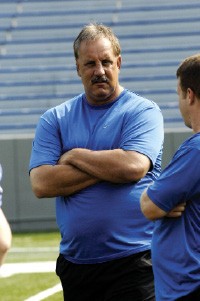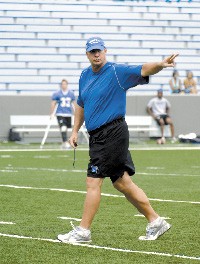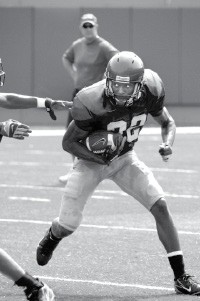However hot, hazy, and humid, August in Memphis is a time for optimism if you’re a football fan. Before the season’s opening kickoff — this Saturday for the University of Memphis, in the Liberty Bowl against Ole Miss — every team from UCF to UCLA is undefeated. For the 2007 Memphis Tigers, optimism is a welcome tonic.
Having survived a 2-10 trainwreck in 2006, head coach Tommy West turned his staff inside out over the off-season. Six of West’s nine full-time staffers are new to the program, the lone holdovers being offensive coordinator Clay Helton, offensive line coach Rick Mallory, and linebackers coach Kenny Ingram. Add the requisite hope and optimism of a new job to the mix and this year’s squad will take its lead from a staff that has little tolerance for any aftertaste from last season.
“They’re good teachers,” says West of his new assistants. “And that’s what coaching is: teaching. I’m really excited about it.”
West dismisses any thoughts of the risk in such a dramatic turnover in staff. “I keep a good grip on things,” he says. “And I do what I think is necessary to move us forward. The [challenge] has been to get everybody on the same page. We know how to win. That’s what I had to impress on them: You’re not coming into a program that hasn’t won. We’re not here to get on your page. You need to get on our page. We’ve been to more bowl games than all of them. And they’ve done a good job of understanding what we do and how we do it.
“When you’ve had a staff together for four or five years,” he continues, “it’s easier for the head coach. The other coaches know what’s expected. That’s my job, to coach the coaches. It’s their job to coach the players.”
Here’s a look at the season ahead through the eyes of three of the new coaches.
Brent Pry (Defensive Line)
The 37-year-old Pry arrives in Memphis having spent the last five seasons at Louisiana-Lafayette (ULL). During Pry’s time at ULL, the Ragin’ Cajuns won a Sun Belt Conference championship and saw three defensive players selected in the NFL draft. Having played collegiately as a safety at Buffalo, Pry has taken a unique path to overseeing defensive linemen.
“I’ve coached them all,” Pry stresses. “When I went to Virginia Tech as a grad assistant, I coached the line for three years. I coached the secondary at Western Carolina, and I’ve also coached linebackers. We had some great defenses at Virginia Tech, and that was primarily because of our front four. You can take a ball game over from the defensive line. If they can’t block you up front, they can’t do much of anything.”
Pry seems every bit as happy to be in Memphis as West is to add him to the mix. “I wanted to work for Tommy West six years ago,” he explains, “and it didn’t work out, but I’ve always had a great amount of respect for him. Coming from Virginia Tech and knowing Tommy when he was at Clemson, I’ve got a lot of respect for the kind of defensive coach he was. I also had a close relationship with [new defensive coordinator] Rick Kravitz.”
Though new to the Mid-South, Pry has a feel for the lay of the land. And he has a unique perspective — optimism, remember — on the team he inherits. “Coming from the Sun Belt Conference,” Pry reflects, “we played a lot of Conference USA schools, so I had an idea of what was good and what wasn’t in this league, and I was very impressed with the talent on this football team. [Last year’s] record was not indicative of the talent.”
 Larry Kuzniewski
Larry Kuzniewski
Darin Hinshaw
Pry has a different angle — again, coming from the Sun Belt — from fans who continue to insist this is SEC country. “Conference USA has a bigger, better athlete,” Pry notes. “There was speed in the Sun Belt, though not as much. The overall makeup of your roster has much greater potential in this league. In the Sun Belt, maybe the top 10 guys could play in this league. I also think there’s a greater commitment from the administration in this league.”
Considering last year’s Tiger team suffered a nine-game losing streak — one that didn’t include the season-opening loss to Ole Miss — how can Pry carry his rosy outlook with a straight face? “Anytime you make a change at the coordinator position, it’s tough,” he stresses. “You’re going from a very different scheme. Joe Lee Dunn’s scheme was atypical. To change from that scheme was difficult. The kids had to be exposed to new adjustments and things they didn’t have to deal with under the old system.
“We had a head start this spring, really diving into the 4-3 and what Tommy and Rick Kravitz want to do,” Pry says. “I expect to see a lot of improvement. The first thing that comes to mind when I look at a defensive line is mentality. Along with coaching technique with this group, I’ve coached the heck out of them when it comes to mentality. The more maturity I can get out of this group, the more commitment. It’s a tough position to play, especially on first and second down. You’ve got to have a mature bunch. Do they understand the work involved? Do they understand the commitment, the unselfish approach? They have to get the most out of every rep, every practice. It’s an image that they’re forming, to be respected by their teammates and their coaches.”
In identifying a leader among his unit, Pry points to a rookie defensive tackle: “Freddie Barnett, the junior-college transfer, has been a real inspiration. He has tremendous ability and all the intangibles. He’s unselfish, talented, and a very big team player. He’s constantly pushing the rest of the group.”
Greg Terrell — a C-USA All-Freshman selection a year ago — is another player fans should spotlight this fall. “Greg has put on about 30 pounds,” Pry says. “He’s bigger and stronger. He’s growing into the new system, and there’s a lot of competition at the [defensive end] position. Greg’s had to work harder than he ever has before. He’s beginning to understand that you’re not going to get by on ability alone.”
 Larry Kuzniewski
Larry Kuzniewski
Rick Kravitz
Darin Hinshaw (wide receivers)
Led by sophomore Duke Calhoun (42 receptions for 681 yards in ’06), the Tiger receiving corps should be a strength this fall, particularly if senior quarterback Martin Hankins builds on his strong finish last season and tailback Joseph Doss keeps opposing defenses honest against the run. The pass-catchers will be guided by 35-year-old Darin Hinshaw, a record-breaking quarterback at Central Florida during his playing days and most recently the offensive coordinator and quarterbacks coach at Georgia Southern. Hinshaw also spent five years at Middle Tennessee State, where the Blue Raiders developed into one of the highest-scoring offenses in the Sun Belt.
Ask Hinshaw about his unit and the coach has to take a breath before reeling off the names he expects to make an impact: Calhoun, Carlos Singleton, Earnest Williams, Steven Black (a junior-college transfer), Carlton Robinzine (recovered from a knee injury that cost him the 2006 season). It’s a case of strength in numbers that the Tiger passing game hasn’t always enjoyed.
“Through the course of a season,” Hinshaw explains, “you’re going to use all your receivers, and they’re gonna have to rotate. When you can rotate a starter and backup and not lose anything, that’s huge. Normally, defensive backs don’t rotate at all, so you have a chance to run some deep routes, tire them out, and not lose anything at receiver.
 Larry Kuzniewski
Larry Kuzniewski
Tommy West
“We run sets with three and four receivers,” Hinshaw continues. “We’re going to move them around, to get them in position to get mismatches. When you have one great receiver, the defense will roll coverage to him. But when you have good receivers on both sides, it creates one-on-one matches. We’ve got to make plays.”
Hinshaw loves the leadership Calhoun has shown at the start of his second college season. “Duke’s always the first in line for sprints,” Hinshaw says. “When you have a guy with talent like his wanting to work, it gets everybody focused.”
Whether it’s size, speed, strength, or versatility, Hinshaw feels the Tiger wideouts are equipped to create their share of headaches for the opposition. “We’ve gained a lot of experience at the position,” he notes. “We’re gonna move Duke around a lot, and we’ll have depth with Maurice Jones. Earnest Williams is going to be one of the top inside receivers in the conference. Usually you have one guy, then you have a bunch of average players that you’re trying to get better. I feel like we have weapons that can catch the ball and score. We’ve got strong receivers: Jones broke the school squat record [for receivers] this summer.”
A quarterback’s blood still pulsing through his veins, Hinshaw recognizes the development of Martin Hankins as critical to his unit’s performance in the season ahead. And he likes what he sees thus far. “[Hankins] has really come along from where he was last year,” Hinshaw says. “He’s gotten bigger, stronger, and he’s gotten a lot more confident with the receivers. When a bunch of guys get hurt, you lose that relationship. [Backup quarterback] Will Hudgens is a leader, too. And he’s had a good summer.”
With seven or eight receivers in the mix, Hankins had better become familiar with faces before he starts gazing downfield. And those receivers he ultimately sees had better catch the ball, because a ready-and-able replacement will be on the sideline.
“That’s what’s great about making each other better, the competition,” Hinshaw says. “If you don’t have someone pushing you from behind, you can get stagnant. As a group, we’re working to make each other better and win as a team. Some games you may catch 10 balls, others you may catch three. It depends on what the defense is doing. Everybody’s gotta be ready to perform and to make plays.”
 Larry Kuzniewski
Larry Kuzniewski
Brent Pry
Rick Kravitz
(defensive coordinator)
It’s almost a universal truth among Tiger fans that the 2006 season was all but compromised with the midseason dismissal of defensive coordinator Joe Lee Dunn. As Pry notes, the adjustments forced upon players — while preparing for the next week’s foe — proved too much for the Tiger defense. With West himself overseeing the scheme transition, important details were lost in translation. The end result: an average of more than 30 points allowed per game.
To the rescue comes Rick Kravitz. Having first filled the role of defensive coordinator in 1986 (at Florida A&M), Kravitz brings a single-minded determination for defensive improvement to the 2007 Tigers. During a decade spent at South Florida, Kravitz coordinated a unit that ranked among the top 20 defenses nationally three times. (Last year — his only season at North Carolina State — the Wolfpack finished 13th in the country against the pass.)
Having been on the opposite sideline, Kravitz welcomes the chance to mold a defense at West’s side. “Knowing Coach West’s defensive background,” Kravitz says, “it was exciting to get the chance to come here and learn some things from him. He’s a fundamentals coach, which I like. He’s a guy who lets you coach. He wants things done his way, which is natural. He’s straightforward.”
 Larry Kuzniewski
Larry Kuzniewski
#22: sophomore wide receiver Duke Calhoun
He won’t go so far as to describe a “Rick Kravitz philosophy to defense,” but the 53-year-old Florida native does believe there is value in change. “I bring — along with the other new coaches — some enthusiasm and excitement. Defensively, we’re developing an attitude. If the ball’s on the one-yard line, you know, we still have a yard to go. We’re being positive, aggressive. If we can improve 2 percent a day, after 20 days we’ve improved 40 percent.”
How is a defense that was so staggered a year ago reshaped into a unit capable of beating Division I-A competition? Kravitz considers the answer elementary. “We have to continue to work on fundamentals and get better at what we do. If we do that, no matter what we run, we’re going to be a better defensive team. Kids have bought into my fundamentals, and that’s how you get better and better.”
Kravitz echoes Pry’s sentiments about Barnett when describing the off-season leaders of his defense. He also says defensive back Dontae Reed — a transfer from Ole Miss — has made a difference. “They encourage each other,” Kravitz notes. “Dontae has gathered players for workouts, taking responsibility and getting things done.”
A new season, a new schedule, and lots of new faces. Why not be optimistic as year seven of the Tommy West era dawns in Memphis?
“With six new coaches,” Pry says, “it forces you to move forward. We weren’t here for [the 2-10 season]. It’s been a breath of fresh air, a renewal.
“This is the most well-disciplined football team I’ve ever been around,” he adds. “And it starts at the top with Coach West. These players — and the coaches — have a tremendous respect for him and how he wants to run this program. The whole group is coming together as a football team.”
The first exam is Saturday against Ole Miss.

 Larry Kuzniewski
Larry Kuzniewski  Larry Kuzniewski
Larry Kuzniewski  Larry Kuzniewski
Larry Kuzniewski  Larry Kuzniewski
Larry Kuzniewski  Larry Kuzniewski
Larry Kuzniewski 


